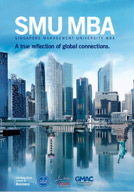
Often dubbed the "future of work", the hybrid model rapidly gained traction during the pandemic. Having had a taste of clearing emails in pyjamas and upping productivity without the distraction of watercooler chats, workers are now choosing to work from home, even after offices have reopened. In fact, Singaporean job seekers are turning down offers without flexible work arrangements, a trend that signals a need for hybrid work as a long-term model for the workplace — even as we inch towards endemic status.
The ability to work from home, on the go, or in an office is certainly attractive for employees seeking flexibility and autonomy. But what are the greatest pitfalls of hybrid work, how can organisations overcome them, and what are the best practices for adopting hybrid work in a post-pandemic economy? We speak with Laurel Teo, a 2022 SMU PhD graduate in Organisational Behaviour and Human Resources, who is now working as a Senior Research Fellow at the Institute of Policy Studies.
The great workplace disconnect
In recent years, there has been a growing trend of employees wanting greater autonomy when it comes to their work arrangements. This has been greatly boosted by worldwide workplace lockdowns during the height of the COVID-19 pandemic, allowing many people to work from home for an extended period. However, if given a choice, many employers and managers are still hesitant to allow their employees to work remotely, as it can be difficult to monitor their on-the-job behaviour. This tension between what employees and employers prefer is likely to continue in the future, as an increasing number of employees seek greater autonomy and flexibility in their work life.
The COVID-19 pandemic has also forced employers to re-evaluate the way they do business. For many, the shift to working from home (WFH) has been a revelation. Employees have been productive, and often more so, while working from the comfort of their own homes. However, some employers are now starting to push back against WFH, arguing that it is detrimental to employee morale and productivity. Big companies such as Apple and investment banks on Wall Street have been leading the charge, fighting to get their workers back in the office, notes Laurel.
For other organisations, the hybrid model can be seen as too much of a hassle to manage, with logistics and scheduling being two main areas of concern. As a result, she notes, citing examples reported in mainstream media, these companies have decided to go fully remote instead, which admittedly is easier for businesses in the digital space.
“At this point, it’s still not entirely clear what will be the new norm going forward,” admits Laurel.
“But what we do know is that the COVID-19 pandemic has forced employers worldwide to operate – and survive – on largely remote working arrangements for about two years or more.
The technology for remote work has existed for decades – but until the pandemic, employers have resisted normalizing remote work as a standard arrangement. Now that the genie is out of the bottle, it would be difficult to revert to purely or largely in-office work practices again.”
Lessons from the pandemic
Many organisations have been quick to shift their workforces to remote arrangements in the wake of the pandemic. While this has helped to keep businesses running, it has also created a number of challenges, both for employees and employers. The extended period of working from home had brought to light some underlying issues that need to be addressed before workplaces progress to long-term hybrid work arrangements.
During the start of the pandemic, workplace trust was an issue due to the sudden implementation of work-from-home arrangements, recalls Laurel. While employers believed that surveillance — some of whom employed keystroke monitoring software — may seem like a way to track time spent on work or monitoring internet activity, it can have lasting, detrimental effects on employee morale.
When employees feel that they are being constantly monitored, it can lead to a feeling of mistrust and paranoia. This in turn can lead to lower levels of productivity and motivation. Moreover, it can also cause employees to spend more time and effort proving their diligence and productivity, rather than working efficiently.
While it is important to take measures to maintain productivity and improve security, they should also trust that their employees are honest and hardworking. Employees, for their part, need to ensure that the trust that is placed in them is not abused, Laurel suggests.
Another challenging aspect of working from home is managing boundaries. It can be difficult to "switch off" from work when there is no physical separation between work and personal or family life. This can lead to greater fatigue and even stress. Employers need to help employees manage this by providing clear expectations and guidelines. Meanwhile, employees should aim to be proactive in setting boundaries, communicating with their employers, and taking breaks.
Due to the rise of such issues, it's important for companies to have clear policies and guidelines in place for both employees and managers about WFH arrangements, Laurel explains. For example, HR policies should incorporate remote and/or flexi-work options into standard or formal policies. Additionally, measurements of productivity and evaluation criteria may need to be reviewed in light of WFH arrangements. And finally, guidelines on supervisor-subordinate reporting processes should be clearly delineated to avoid any confusion or misunderstanding. By thoughtfully addressing these issues, companies can help ensure that WFH arrangements are successful for both employees and managers.
How to make hybrid work a success in the long term
As the hybrid model becomes the new norm for many people around the world, organisations need to be aware of potential drawbacks over time. One of the biggest considerations: the lack of face-to-face interaction with co-workers. This can make it difficult to build relationships and trust, and can also hinder knowledge transfer and idea sharing.
In an office setting, people are more likely to have spontaneous interactions with their co-workers, which can lead to new relationships, ideas, and collaborations. However, when people are working from home, they are less likely to have these types of interactions.
Moreover, employers also need to guard against discriminating against people who prefer hybrid or largely WFH arrangements, says Laurel. While certain employers prefer the face-to-face interaction and collaboration that comes with working in an office, it is important to remember that WFH is not inherently inferior to working in an office; it simply offers different advantages and disadvantages.
Those who prefer WFH should not be penalised in their career advancement, as employers should judge employees on their actual performance rather than on their preference for WFH.
“Employers should judge employees on their actual performance, rather than what they think or assume work arrangement preferences to signal,” elaborates Laurel.
Rather than relying too much on "presence" or digital "face time", a better approach is to consider different ways to measure performance and productivity. For instance, look at the actual quality of work and results produced. This will not only help to improve remote work arrangements; but also create a more productive and positive workplace overall.
As an employee, it is important to look for signs that the company you plan to work for has or is incorporating hybrid work as part of its long-term strategy and planning, advises Laurel. This includes looking for clear and formal outlines of hybrid or flexi-work arrangements in company policies and even employment contracts. By doing this, you can be sure that the company you work for values employee flexibility and is committed to offering hybrid working arrangements as a long-term solution.
Speak to our Admissions Advisors
Singapore Management University
Lee Kong Chian School of Business
Graduate Programmes Office, Level 4
50 Stamford Road, Singapore 178899
Tel: +65 6828 0882
Join us at the upcoming events
Shop Nos K6 / K7, Off Nh 8, Phase 2, DLF Cyber City, Gurugram 122002, India
Mitsui Garden Hotel Toyosu Premier
2-2-1 Toyosu, Koto, Tokyo, 135-0061 Japan
You may also be interested in
Executive Master of Business Administration (EMBA)
